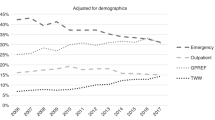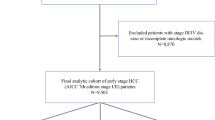Abstract
Background
While hepatocellular carcinoma (HCC) is ideally diagnosed outpatient by screening at-risk patients, many are diagnosed in Emergency Departments (ED) due to undiagnosed liver disease and/or limited access-to-healthcare. This study aims to identify sociodemographic/clinical factors associated with being diagnosed with HCC in the ED to identify patients who may benefit from improved access-to-care.
Methods
HCC patients diagnosed between 2012 and 2014 in the ED or an outpatient setting [Primary Care Physician (PCP) or hepatologist] were identified from the US Safety-Net Collaborative database and underwent retrospective chart-review. Multivariable regression identified predictors for an ED diagnosis.
Results
Among 1620 patients, median age was 60, 68% were diagnosed outpatient, and 32% were diagnosed in the ED. ED patients were more likely male, Black/Hispanic, uninsured, and presented with more decompensated liver disease, aggressive features, and advanced clinical stage. On multivariable regression, controlling for age, gender, race/ethnicity, poverty, insurance, and PCP/navigator access, predictors for ED diagnosis were male (odds ratio [OR] 1.6, 95% confidence interval [CI]: 1.1–2.2, p = 0.010), black (OR 1.7, 95% CI: 1.2–2.3, p = 0.002), Hispanic (OR 1.6, 95% CI: 1.1–2.6, p = 0.029), > 25% below poverty line (OR 1.4, 95% CI: 1.1–1.9, p = 0.019), uninsured (OR 3.9, 95% CI: 2.4–6.1, p < 0.001), and lack of PCP (OR 2.3, 95% CI: 1.5–3.6, p < 0.001) or navigator (OR 1.8, 95% CI: 1.3–2.5, p = 0.001).
Conclusions
The sociodemographic/clinical profile of patients diagnosed with HCC in EDs differs significantly from those diagnosed outpatient. ED patients were more likely racial/ethnic minorities, uninsured, and had limited access to healthcare. This study highlights the importance of improved access-to-care in already vulnerable populations.

Similar content being viewed by others
References
HealthIT. Telemedicine and Telehealth. United States Department of Health and Human Services. https://www.healthit.gov/topic/health-it-initiatives/telemedicine-and-telehealth. Published 2017. Accessed 15 Apr 2020.
Ghouri YA, Mian I, Rowe JH. Review of hepatocellular carcinoma: Epidemiology, etiology, and carcinogenesis. J Carcinog. 2017;16:1.
Sayiner M, Golabi P, Younossi ZM. Disease burden of hepatocellular carcinoma: a global perspective. Dig Dis Sci. 2019;64(4):910–7.
Fateen W, Ryder SD. Screening for hepatocellular carcinoma: patient selection and perspectives. J Hepatocell Carcinoma. 2017;4:71–9.
Kim SY, An J, Lim YS, et al. MRI with liver-specific contrast for surveillance of patients with cirrhosis at high risk of hepatocellular carcinoma. JAMA Oncol. 2017;3(4):456–63.
Simmons OL, Feng Y, Parikh ND, Singal AG. Primary care provider practice patterns and barriers to hepatocellular carcinoma surveillance. Clin Gastroenterol Hepatol. 2019;17(4):766–73.
Goldberg DS, Valderrama A, Kamalakar R, Sansgiry SS, Babajanyan S, Lewis JD. Hepatocellular carcinoma surveillance rates in commercially insured patients with noncirrhotic chronic hepatitis B. J Viral Hepat. 2015;22(9):727–36.
Goldberg DS, Valderrama A, Kamalakar R, Sansgiry SS, Babajanyan S, Lewis JD. Hepatocellular carcinoma surveillance among cirrhotic patients with commercial health insurance. J Clin Gastroenterol. 2016;50(3):258–65.
Abdelsattar ZM, Hendren S, Wong SL. The impact of health insurance on cancer care in disadvantaged communities. Cancer. 2017;123(7):1219–27.
CDC. No usual source of health care among adults aged 18–64, by selected characteristics: United States, average annual, selected years 1993–1994 through 2015–2016. US Department of Health and Human Services. https://www.cdc.gov/nchs/data/hus/2017/062.pdf. Published 2017. Accessed 18 March 2020.
Patel N, Yopp AC, Singal AG. Diagnostic delays are common among patients with hepatocellular carcinoma. J Natl Compr Canc Netw. 2015;13(5):543–9.
Ho CK, Maselli JH, Terrault NA, Gonzales R. High rate of hospital admissions among patients with cirrhosis seeking care in U.S. emergency departments. Dig Dis Sci. 2015;60(7):2183–9.
ASPE. Definition of Safety Net Hospitals. United States Department of Health and Human Services. https://aspe.hhs.gov/report/environmental-scan-identify-major-research-questions-and-metrics-monitoring-effects-affordable-care-act-safety-net-hospitals/c-definition-safety-net-hospitals. Published 2013. Accessed 12 May 2020.
AJCC. AJCC Cancer Staging Manual, Eighth Edition. American College of Surgeons. https://cancerstaging.org/references-tools/deskreferences/Documents/AJCC Cancer Staging Form Supplement.pdf. Published 2018. Accessed 16 July 2020.
Franco RA, Fan Y, Jarosek S, Bae S, Galbraith J. Racial and Geographic Disparities in Hepatocellular Carcinoma Outcomes. Am J Prev Med. 2018;55(5 Suppl 1):S40–8.
Yang B, Liu JB, So SK, et al. Disparities in hepatocellular carcinoma incidence by race/ethnicity and geographic area in California: Implications for prevention. Cancer. 2018;124(17):3551–9.
Zhang BH, Yang BH, Tang ZY. Randomized controlled trial of screening for hepatocellular carcinoma. J Cancer Res Clin Oncol. 2004;130(7):417–22.
Meringer H, Shibolet O, Deutsch L. Hepatocellular carcinoma in the post-hepatitis C virus era: Should we change the paradigm? World J Gastroenterol. 2019;25(29):3929–40.
Kim NJ, Magee C, Cummings C, Park H, Khalili M. Liver disease monitoring practices after hepatitis C cure in the underserved population. Hepatol Commun. 2018;2(10):1274–83.
Kaplan DE, Chapko MK, Mehta R, et al. Healthcare costs related to treatment of hepatocellular carcinoma among veterans with cirrhosis in the United States. Clin Gastroenterol Hepatol. 2018;16(1):106–14 e105.
Shetty A, Jun Yum J, Saab S. The Gastroenterologist's Guide to Preventive Management of Compensated Cirrhosis. Gastroenterol Hepatol (N Y). 2019;15(8):423–30.
CDC. Recommendations for the identification of chronic hepatitis C virus infection among persons born during 1945–1965. US Department of Health and Human Services. https://www.cdc.gov/mmwr/preview/mmwrhtml/rr6104a1.htm. Published 2012. Accessed 19 March 2020.
Ward JW. The hidden epidemic of hepatitis C virus infection in the United States: occult transmission and burden of disease. Top Antivir Med. 2013;21(1):15–9.
Marrero JA, Kulik LM, Sirlin CB, et al. Diagnosis, staging, and management of hepatocellular carcinoma: 2018 Practice Guidance by the American Association for the Study of Liver Diseases. Hepatology. 2018;68(2):723–50.
Harris PS, Hansen RM, Gray ME, Massoud OI, McGuire BM, Shoreibah MG. Hepatocellular carcinoma surveillance: an evidence-based approach. World J Gastroenterol. 2019;25(13):1550–9.
CDC. Hepatitis C Questions and Answers for the Public. Department of Health and Human Services. https://www.cdc.gov/hepatitis/hcv/cfaq.htm. Published 2020. Accessed 18 March 2020.
Weisgrau S. Issues in rural health: access, hospitals, and reform. Health Care Financ Rev. 1995;17(1):1–14.
Coughlin SS, Clary C, Johnson JA, et al. Continuing Challenges in Rural Health in the United States. J Environ Health Sci. 2019;5(2):90–2.
Li X, Deng Y, Tang W, et al. Urban-rural disparity in cancer incidence, mortality, and survivals in Shanghai, China, During 2002 and 2015. Front Oncol. 2018;8:579.
Acknowledgment
This research was supported by the National Institute of Health under a training Grant, T32CA211034.
Author information
Authors and Affiliations
Corresponding author
Ethics declarations
Disclosures
All authors have no conflicts of interest to disclose.
Additional information
Publisher's Note
Springer Nature remains neutral with regard to jurisdictional claims in published maps and institutional affiliations.
Rights and permissions
About this article
Cite this article
Kronenfeld, J.P., Ryon, E.L., Goldberg, D. et al. Disparities in Presentation at Time of Hepatocellular Carcinoma Diagnosis: A United States Safety-Net Collaborative Study. Ann Surg Oncol 28, 1929–1936 (2021). https://doi.org/10.1245/s10434-020-09156-4
Received:
Accepted:
Published:
Issue Date:
DOI: https://doi.org/10.1245/s10434-020-09156-4




